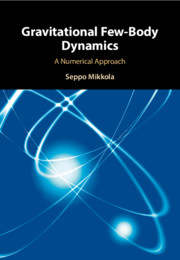Book contents
- Frontmatter
- Dedication
- Contents
- Preface
- Introduction
- 1 The Problems
- 2 Two-Body Motion
- 3 Analytical Tools
- 4 Variation of Parameters
- 5 Numerical Integration
- 6 Symplectic Integration
- 7 KS-Regularization
- 8 Algorithmic Regularization
- 9 Motion in the Field of a Black Hole
- 10 Artificial Satellite Orbits
- References
- Index
8 - Algorithmic Regularization
Published online by Cambridge University Press: 06 April 2020
- Frontmatter
- Dedication
- Contents
- Preface
- Introduction
- 1 The Problems
- 2 Two-Body Motion
- 3 Analytical Tools
- 4 Variation of Parameters
- 5 Numerical Integration
- 6 Symplectic Integration
- 7 KS-Regularization
- 8 Algorithmic Regularization
- 9 Motion in the Field of a Black Hole
- 10 Artificial Satellite Orbits
- References
- Index
Summary
The gravitational field of a black hole differs significantly from the point-mass field that is normally used in N-Body simulations. The additional terms needed are called Post-Newtonian ones and abbreviated as PN-terms. They depend in addition of coordinates also on velocities. Thus the methods discussed in Section~\ref{v-dependence} must be used in numerical integration. An other problem is that the orbital elements of two-body motions cannot any more be evaluatedin the same way as in the Newtonian point-mass dynamics. Finally one must remember that black holes rotate and form a so called Kerr-hole that produce a fielddiffering from the non-rotating one and the rotation, the black hole spin, changes due to interactions withother bodies. These complexities is discussed and formulae given in this short chapter
Information
- Type
- Chapter
- Information
- Gravitational Few-Body DynamicsA Numerical Approach, pp. 173 - 210Publisher: Cambridge University PressPrint publication year: 2020
